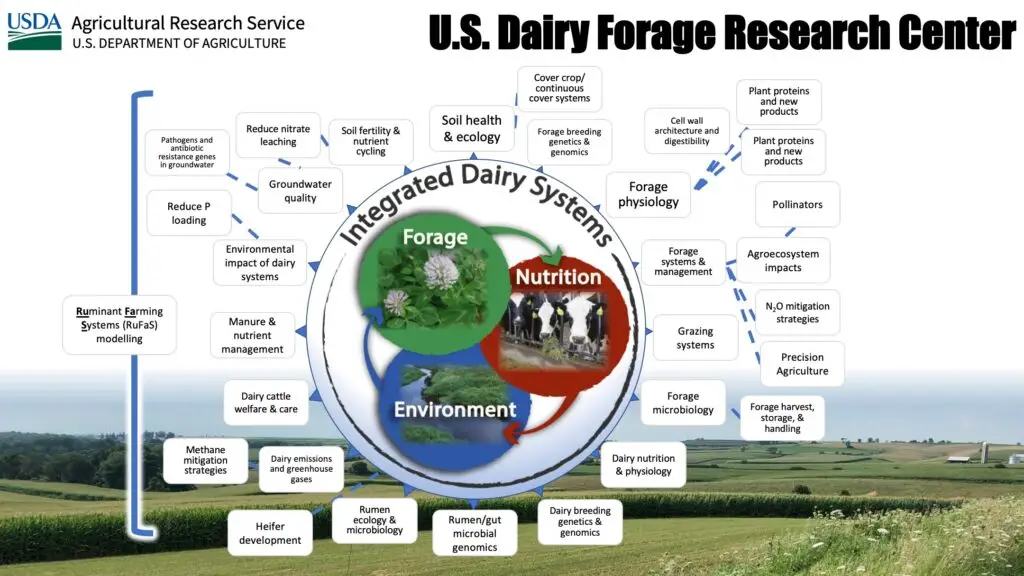
Expanding dairy forage research
 By Dennis Hancock, Ph.D., U.S. Dairy Forage Research Center
By Dennis Hancock, Ph.D., U.S. Dairy Forage Research Center
Since 1979, the U.S. Dairy Forage Research Center (USDFRC) has contributed much to the foundational research and development that has underpinned changes in the dairy industry during the last four decades.
Scientists at USDFRC have authored or coauthored more than 40 reference books used in classrooms and on the shelves of practitioners, nutritionists, crop consultants, and veterinarians. Those books and management guides have been influenced by the results published in more than 4,000 publications in our first 40 years. Additionally, our scientists have released more than 30 grass or legume cultivars, 10 decision aids and numerous other products/processes patented to ensure public benefit. Our hope is to see that progress continues at an ever-increasing rate.
Our mission at the USDFRC is to focus on the integrated nature of the dairy system. Every dairy producer can tell you that virtually every aspect of the dairy enterprise interacts with another aspect. Linked like a spider’s web, even a small change to one aspect can have cascading effects on other aspects. This is why our research attempts to examine these interactions with scientists from multiple disciplines.
Our research is conducted in five-year plans. Within the last two years, all eight of our research accounts have revised their five-year plans and each were reviewed by university colleagues and industry experts. As a collective, we work on 32 primary research topics, which are depicted in the graphic below.
While several of our research endeavors continue to refine our collective understanding of basic processes (e.g., impacts of cell wall architecture on forage digestibility, roles of endemic microbes on silage fermentation, functions of specific strains of microbes in the rumen, ration development strategies that are more efficient in using protein, etc.), we have taken on several new topics in our new research plans.
Here are some highlights:
- Integrating cover crops into dairy forage cropping systems and evaluating the impacts on soil microbial diversity, nutrient cycling, and health;
- Expanding our plant breeding efforts to include legumes, perennial grasses, and annual grasses (for cover crops and/or use as a forage crop);
- Examining legume crops for plant proteins or other compounds that could be concentrated or extracted for enhanced nutrition or as nutraceutical products in the dairy industry or beyond;
- Developing new tools and recommendations for using precision ag techniques in dairy forage and cover crop production;
- Characterizing the genome of major rumen microbes and better understanding the development of the rumen microbiome in highly efficient animals;
- Evaluating additives and forage characteristics that could mitigate methane emissions;
- Investigating the mechanism of antibiotic resistance gene transfer via groundwater and distinguishing bovine and human sources;
- Further developing the Ruminant Farming System (RuFaS) model as a comprehensive, biophysical model of all dairy enterprises.
In addition to these new topics, we will soon break ground on a new research dairy to replace our 43-year-old dairy in Prairie du Sac, Wisconsin. This new facility will allow us to do research relevant to automated milking systems, as well as more advanced trials in conventional freestalls and conducting individualized trials in the tiestalls of an Advanced Animal Nutrition unit. We will be able to conduct detailed greenhouse gas emissions studies in the metabolic chambers of the Animal Emissions unit, as well as basic physiology work in a new youngstock barn. We anticipate construction to begin in the spring of 2024 and finish by the end of 2026 or early 2027.
If you are interested in learning more about our efforts on these highlighted research endeavors, our continuing efforts on other research topics, or our plans and progress on building our new world-class research facility, visit here.
| Category: |
Forage Foundations |


